Chapter 2
Your First 3ds Max Project
This chapter gets your engine revving right away. It begins with an overview of the user interface (UI) and starts you off with an exercise that will expose you to a few 3ds Max workflows and practices. The goal of the chapter is to put some concepts from the previous chapter into production so you can get going quickly and get experience with the interface.
Topics in this chapter include the following:
- Getting around in 3ds Max
- Project and file-management workflow
- The 3ds Max interface
- Jumping headlong into production
At this point, it’s important not to get caught up in the details of this great machine. Don’t worry about the steps, buttons, menus, switches, and levers; just allow yourself to become comfortable with the tools that you use to create your artwork. Creating art is never about which button to press; it’s about what to create. Always remember that, and your studies will be a great deal more successful.
Jumping straight into an exercise without knowing how to get around the interface might seem a little weird. However, you’ll find everything you ever wanted to know, and then some, in Chapter 3, “The 3ds Max Interface.” Learning is an experimental art, and there’s no better way to learn than to start experimenting as soon as you can. The overall goal of this chapter is to expose you to the UI and show you how to get some things done in Max. Then you can proceed to the next chapter for a debriefing. (If you prefer, you can skip ahead to Chapter 3, get a tour of the UI, and then come back to this chapter for your first experience.)
Project and File-Management Workflow
3ds Max provides several subfolders automatically grouped into projects for you. Different kinds of files are saved in categorized folders under the Project folder. For example, scene files are saved in a Scenes folder and rendered images are saved in a Render Output folder in the Project folder. The projects are set up according to what types of files you are working on, so everything is neat and organized from the get-go. 3ds Max will automatically create this folder structure for you once you create a new project, and its default settings will keep the files organized in that manner.
The conventions followed in this book and on the accompanying web page (www.sybex.com/go/) will follow this project-based system so that you can grow accustomed to it and make it a part of your own workflow. File organization is extremely important for professional work. If you do a lot of CG for fun or profit, it pays to be organized.
The exercises in this book are organized into specific projects, such as the one you will tackle in this chapter, Mobile. The Mobile project will be on your hard drive, and the folders for your scene files and rendered images will be in it. Once you copy the appropriate projects to your hard drive, you can tell 3ds Max which project to work on by choosing Application menu ⇒ Manage ⇒ Set Project Folder. This will send the current project to that project folder. For example, when you save your scene, 3ds Max will automatically take you to the Scenes folder of the current project.
Before we begin any project, we’ll briefly explain the naming conventions and suggest a folder structure. Using these naming conventions and structures is a good habit to develop.
Naming Conventions
Every studio and professional production company worth its salt has an established naming convention for its files and folders. This is a documented procedure that dictates how to name files and (usually) where to store them. Most organizations have different conventions, but the point is to have a convention and stick to it.
Students, in particular, tend to forgo any semblance of organization in their file-naming procedures. A common mistake is to save files to the local disk on the school computer, only to have the files erased by the support teams during the school’s weekly purge. Designating a specific place on your PC or server for all your project files is important.
Figure 2-1: Click Make New Folder and enter the folder name.
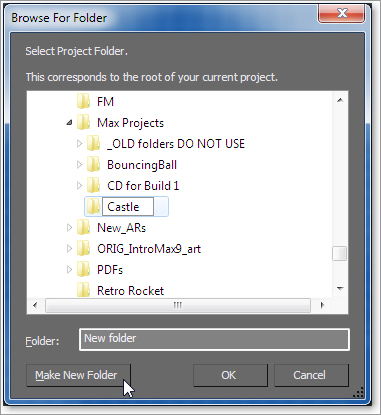
In addition to finding a suitable place to store your files, you need to name the files following some sort of convention. Your files will not only look neat when you’re browsing, but they’ll make sense months later when you try to figure out where you saved that finished scene file that you need. Typically, you should name a scene file with a project name or an abbreviation of such, then a brief description of what the file is, and a version number.
For example, if you are working on a project about a castle, begin by setting a new project called Castle. Choose Application menu ⇒ Manage ⇒ Set Project Folder. On your hard drive, click the Make New Folder button (Figure 2-1) to create a folder named Castle. 3ds Max will automatically create the project and its folders.
Once you save a scene, one of your scene filenames should look like this: Castle_GateModel_v05.max. This tells you right away it’s a scene from your Castle project, and that it is a model of the gate. The version number tells you that it’s the fifth iteration of the model and possibly the most recent version. Following a naming convention will save you oodles of time and aggravation.
Version Up!
The naming convention just mentioned used a version number appended to the end of the filename. After you’ve spent a significant amount of time working on your scene, or after you’ve made a major change or big breakthrough in your work, you will want to version up. This means you save your file using the same name, but you increase the version number by one to tell yourself or your colleagues that there was a big change since the last version. Version numbers are also useful for keeping track of your progress.
Version numbers can also save your hide. If you start down a path on your scene, but discover after hours of work (and saving your work as you went along, versioning up as you went) that this was in fact the wrong way to go, you can simply close the scene and open one of the previous versions that you created before you started going in the wrong direction. This happens a lot more than you might think.
Disk space is cheap and scene files, even huge ones, aren’t all that big in the face of terabytes of space that you can buy for around $100. Keep a notebook and a pen next to your workstation so that you can take notes on your progress and record exactly what you did during your work sessions. Professionals do this regularly; those who don’t should. They can’t afford to waste time trying to figure out what file they should load to access a particular chunk of work.
The Basic Project Structure Used in This Book
Each exercise in this book will be its own 3ds Max project. Pick a place on your hard drive and start there. Create a folder called Max Projects on your C: drive (you can create one anywhere you want, including your My Documents folder). Place all of your projects in this folder. This will make it easy to find your files and back them up to DVD or backup drive.
Let’s create the first project we’ll be working on, Mobile. Select Application menu ⇒ Manage ⇒ Set Project Folder, navigate to your 3ds Max Projects folder (or My Documents folder), and then click Make New Folder. Name the folder Mobile. 3ds Max will create the subfolders for the project once you click OK, as shown in Figure 2-2.
Figure 2-2: Standard subfolders for the Mobile project
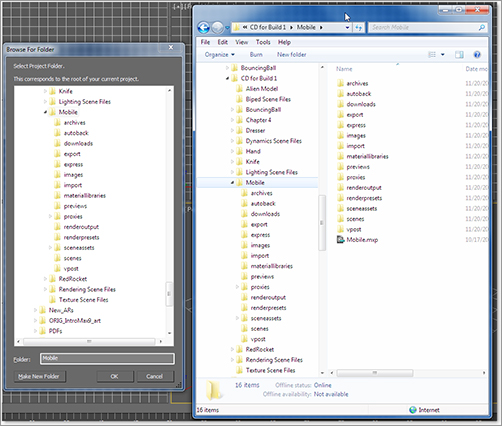
That’s pretty much it. Having a naming convention is easy; sticking to it is not, especially when you’re first starting out. Make sure you stick to it.
Saving Your Scenes in Max
Save your scene frequently to protect yourself from mistakes and from losing your work. Choosing Application menu ⇒ Save updates the current scene by overwriting the last save of the scene. If the scene was not previously saved, this command opens the Save File As dialog box. Using it, you can select where to save the scene and enter your scene’s name. If you are working in a scene file already, I recommend using Save As so you do not accidentally overwrite your current work. You can also use an incremental save function, discussed shortly.
Figure 2-3: Click the Increment button to version up.

To version up, you can save by using Application menu ⇒ Save As and manually changing the version number appended to the end of the filename. 3ds Max also lets you do this automatically by using an increment feature in the Save As dialog box. Simply name your scene file and click the Increment button (the + icon) to the right of the filename text (Figure 2-3).
Clicking the Increment button will append the filename with 01, then 02, then 03, and so on as you keep saving your work using Save As and the Increment button. In the previous example, the scene’s base filename was SceneName_v. Clicking the Increment button added the two-digit version number after the _v. Adding the _v is a personal preference, of course, but it keeps with the naming convention set up in this book. It looks nicer, and you can easily determine the version number for your file by reading the number after the _v.
Here is a brief rundown of what you need to know about the UI and how to navigate in 3ds Max’s 3D space. We will cover the interface in more detail in the next chapter, so feel free to jump back and forth if you need to know more about the UI.
Figure 2-4 shows theUI. At the very top left of the application window is a large icon (with 3ds Max’s logo) called the Application menu (aka Application button) which gives access to many file operations such as Save and Open. Running along the top also is the Quick Access toolbar, which provides access to common commands, and the InfoCenter for various Autodesk applications’ support. Just below that is the menu bar, which runs across the top of the UI. The menus give you access to a ton of commands—from basic scene operations, such as Undo, to advanced tools you may need for a scene. Immediately below the menu bar is the Main toolbar. It contains several icons for functions such as the three Transform tools (Move, Rotate, and Scale). You will use some of these icons for the Mobile exercise. They are more fully explained in Chapter 3.
Figure 2-4: The 3ds Max 2011 Interface
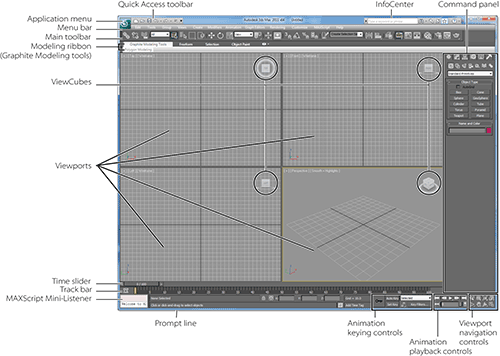
Some of the most important commands in the Quick Access toolbar are the Save File and Open File commands as well as the all important Undo Scene Operation and Redo Scene Operation functions. If you do something and then wish you hadn’t, click the Undo Scene Operation icon (the icon on the left in Figure 2-5) or press Ctrl+Z. To redo a command or action that you just undid, click the Redo Scene Operation button (the icon on the right in Figure 2-5) or press Ctrl+Y.
Figure 2-5: The Undo Scene Operation and Redo Scene Operation buttons
The Command Panel
A tremendously important part of the 3ds Max UI is the Command panel, a vertical column or panel on the right side of the UI. It is segmented into tabs, as shown in Figure 2-6. Each tab displays the buttons and icons for a particular part of your workflow, such as creating objects, modifying objects, and animating objects. In each tab, the functions are grouped under headings that can be expanded or collapsed by clicking on the heading title. A plus sign next to the heading name, known as a rollout, means that you can expand the heading’s view; a minus sign means that you can collapse the heading to save space.
Figure 2-6: The tabs in the Command panel are segmented into headings called rollouts that group similar functions and icons.

If the Command panel is longer than what you can see vertically on your screen, you can mouse over a blank area of the Command panel, and the arrow pointer will change to a hand pointer, as shown in Figure 2-6, when it is not on a button or icon. While the pointer is a hand, you can click and drag to move the current panel up and down in the Command panel to see more functions in that space. You can also click on the far right side of the panel to scroll up and down if you don’t want to use the hand.
The viewport controls (Figure 2-7), which contain icons for various options for the 3D world windows (called viewports), are in the lower-right corner of the UI. These functions allow you to navigate the windows and their 3D space. However, you may find it easier to use hot keys rather than icons to invoke most of these functions. We will cover navigating 3D space and the appropriate hot keys next.
Figure 2-7: The viewport controls

Viewports
You’ll be doing most of your work in the viewports. These windows represent 3D space using a system based on Cartesian coordinates. That is a fancy way of saying “space on X-, Y-, and Z-axes.” All CG programs, including 3ds Max, are based on this coordinate system.
You can visualize X as left–right, Y as up–down, and Z as in–out (into and out of the screen). The coordinates are expressed as a set of three numbers such as (0, 3, –7). These coordinates represent a point that is at 0 on the X-axis, three units up on the Y-axis, and seven units back on the Z-axis.
Four-Viewport Layout
3ds Max’s viewports are the windows into your scene (Figure 2-8). By default, there are four main views: Front, Top, Left, and Perspective. The first three—Front, Top, and Left—are called Orthographic (2D) views. They are also referred to as modeling windows. These windows are good for expressing exact dimensions and size relationships, so they are good tools for sizing up your scene objects and fine-tuning their layout.
The name of each viewport is listed in the viewport’s upper-left corner between a plus sign and a display-mode name.
Figure 2-8: The 3ds Max viewports
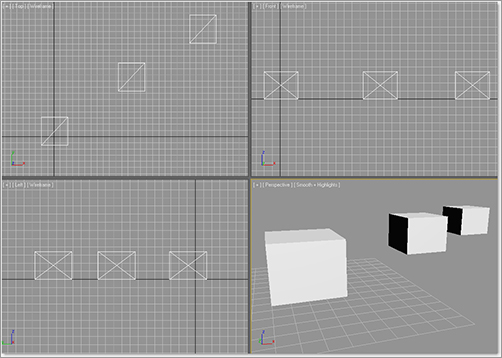
The Perspective viewport displays objects in 3D space using perspective. Notice in Figure 2-8 how the distant cubes seem to get smaller in the Perspective viewport. In actuality, they are the same size, as you can see in the Orthographic viewports. The Perspective viewport gives you the best representation of what your output will be.
To select a viewport, click in a blank part of the viewport (not on an object). If you do have something selected, it will be deselected when you click in the blank space. You can also right-click anywhere in an inactive viewport to activate it without selecting or deselecting anything. When active, the view will have a mustard yellow highlight around it. If you right-click in an already active viewport, you will get a pop-up context menu called the Quad menu. You can use this shortcut menu to access some basic commands for a faster workflow. We will cover this and other shortcut menus in the next chapter.
Display of Objects and Axes in a Viewport
Viewports can display your scene objects in a few different ways. If you click the viewport’s name, you can switch that panel to any other viewport angle or point of view. If you click the viewport display mode name (shown as [Smooth + Highlights] in Figure 2-9), a menu will appear (Figure 2-9) to allow you to change the display mode. The most common view modes are Wireframe mode and Smooth + Highlights mode. Wireframe mode displays the edges of the object. It is the fastest to use because it requires less computation on your video card. The Smooth + Highlights mode is a shaded view where the objects in the scene appear solid. You will get the chance to experiment with different display modes in the upcoming Mobile exercise.
Each viewport displays a ground plane grid (as shown in the Perspective viewport), called the Home Grid (Figure 2-10). This is the basic 3D-space reference system. It’s defined by three fixed planes on the coordinate axes (X, Y, Z). The center of all three axes is called the origin. This is where the coordinates are (0, 0, 0). The Home Grid is visible in 3ds Max’s default settings when you start the software, but it can be turned off in the right-click Viewport menu. You can also toggle the grid by pressing the G key.
The Perspective viewport has a red, green, and blue axis marker in which the X-axis is red, the Y-axis is green, and the Z-axis is blue. 3ds Max uses this red, green, and blue color scheme to represent the X-, Y-, and Z-axes throughout the interface.
Most 3D packages use red, green, and blue to represent X-, Y-, and Z-axes, respectively. It’s not just a 3ds Max thing.
Figure 2-9: Click to see the viewport display mode options.
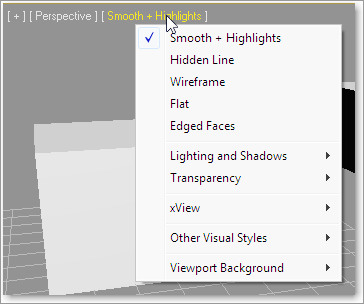
Figure 2-10: The Home Grid in the Perspective viewport
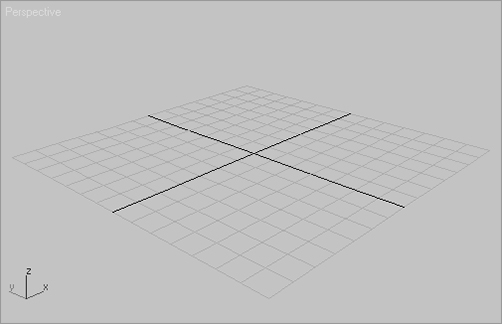
Selecting Objects in a Viewport
Selecting objects in a viewport is as easy as clicking them. If the object is displayed in Wireframe mode, its wireframe will turn white while it is selected. If the object is displayed in a Shaded mode, a white bracket will appear around the object as shown in Figure 2-11.
Figure 2-11: The white frame indicates the object is selected.

To select multiple objects, hold down the Ctrl key as you click additional objects to add to your selection. If you Ctrl+click an active object, you will deselect it. You can clear all of your active selections by clicking anywhere an empty area of the viewport.
The Alt key can be used to subtract objects from a selection set.
Changing/Maximizing the Viewports
To change the view in any given viewport—for example, to go from a Perspective view to a Front view—click the current viewport’s name. From the menu, select the view you want to have in this viewport, as shown in Figure 2-12.
Figure 2-12: Click to change the view.
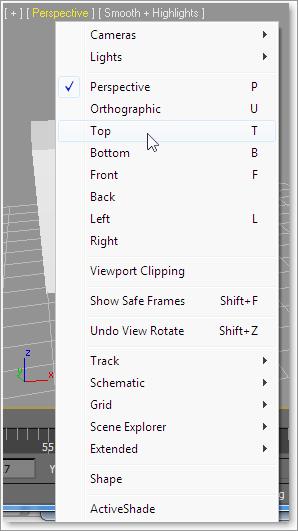
A faster way to change viewports is by using keyboard shortcuts. To switch from one view to another, press the appropriate key on the keyboard, as shown in the following table:
| Viewport | Keyboard Shortcut |
| Top view | T |
| Bottom view | B |
| Front view | F |
| Left view | L |
| Camera view | C |
| Orthographic | U |
| Perspective view | P |
If you want to have a larger view of the active viewport than is provided by the default four-viewport layout, press the Maximize Viewport Toggle icon (![]() ) in the lower-right corner of the Max window. You can also use the Alt+W keyboard shortcut to toggle between the maximized and four-viewport views.
) in the lower-right corner of the Max window. You can also use the Alt+W keyboard shortcut to toggle between the maximized and four-viewport views.
Viewport Navigation
To work effectively, you will need to navigate in 3D space. 3ds Max allows you to move around its viewports either by using key/mouse combinations, which are highly preferable, or by using the viewport controls found in the lower-right corner of the 3ds Max UI. A full explanation of the viewport controls is in the next chapter. However, to navigate within the views, you should become familiar with the key/mouse combinations now.
Open a new, empty scene in 3ds Max. Experiment with the following controls to get a feel for moving around in 3D space. If you are new to 3D, this may seem odd at first, but it will become easier as you gain experience, and it should become second nature in no time. If you are coming to 3ds Max from another 3D package, such as Maya, you will notice several things that will take a little getting used to, but you will also notice similarities. With time and practice, you should be able to hop back and forth between packages with little confusion.
Pan Panning a viewport will slide the view around the screen. Using the middle mouse button (abbreviated in the remainder of this text as MM), click in the viewport and drag the mouse pointer to move the view.
Zoom Zooming will move your view closer to or farther away from your objects. To zoom, press Ctrl+Alt and MM+click in your viewport, and then drag the mouse up or down to zoom in or out, respectively. It is more common to use the scroll wheel to zoom, however.
Zooming is sometimes called dollying in other packages; 3ds Max also has a dolly function, but it is active only when you are in a Camera viewport. (3ds Max differentiates between Camera viewports and Perspective viewports, unlike other packages.)
Orbit Orbit will rotate your view around your objects. To arc rotate, press Alt and MM+click and drag in the viewport. By default, Max will rotate (or tumble, as it’s called in some other CG programs) about the center of the viewport to change your perspective.
The arc rotate move is used primarily in the Perspective viewports and is not used in the Orthographic viewports. If you accidentally arc rotate in one of the orthographic views, you will be given a new orthographic view that shows your model in a 3D view that is not actually in perspective. This view will be similar to a perspective view. However, it will remain orthographic, meaning that there will be no vanishing point or perspective shift in the view; it is not a real camera view. You can reset the view back to your straight orthogonal view by right-clicking the User viewport’s name and selecting your original view.
Jumping Headlong into Production
Let’s get busy and dive right into 3ds Max and create a scene that we will animate later using very simple objects so you can become familiar with the UI. You may not understand the reasons for all the things you’re about to do, but you will get a quick trial by fire by getting into the program and following these steps, which will guide you through some of the basic workflows for 3ds Max.
For your first experience, we will create a simple mobile. This example will teach you the basics of object creation and manipulation and in Chapter 8, “Introduction to Animation,” you will learn about hierarchies and about setting and editing keyframes to create animation.
Plan of Attack for Making Objects
It’s always a good idea to go into something with a goal in mind. Knowing, even roughly, where you are headed will make things much easier. In production work, setting down a plan and having clear goals for your animation is very important. Without a good idea of where you need to go, you’ll end up floundering and losing out on the whole experience. With that in mind, our goal in this chapter is to create a finished mobile like the ones that hang over baby cribs. You will animate the mobile in Chapter 8. Because this is ostensibly your first foray into 3ds Max, let’s start with a simple object so we won’t be bogged down with the specifics of creating masterful models. Instead, we’ll use simple objects that are very easily created in 3ds Max.
Hierarchies
Figure 2-13: The completed mobile object
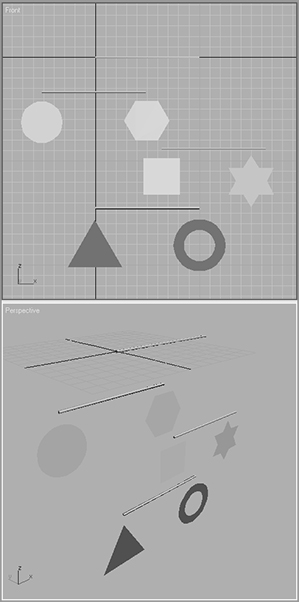
Once we model the mobile, we’ll set up the pieces for animation. We will do this by creating proper hierarchies within the scene. The concept of hierarchy is a common feature in almost all CG packages. The hierarchy in a CG scene deals with how objects are arranged in a scene in relation to each other. Parents in a hierarchy lead children; where a parent goes, the children follow. When you translate (move) or rotate or scale a parent object, its children will move, turn, or scale along with it.
However, children retain the ability to move individually under their parent’s supervision. The Mobile exercise is a perfect way to demonstrate the idea of hierarchies, and we’ll revisit it for that purpose in Chapter 8. Our task here is to create the scene and setup the mobile’s parts.
Take a look at Figure 2-13, which displays the completed mobile. The top bar (the parent), from which the other bars hang, rotates and takes the lower bars (its children) with it. In Chapter 8, we will animate the mobile parts to rotate individually, just as a real mobile would.
The dangling shapes on the lower bars are the children of their respective bars. Those lower bars are children of the bars above them, and so on up to the top bar that controls the rotation of the entire mobile. Once you begin working on it, it will make more sense. As you can see now, hierarchy will play an important part in animation.
Don’t get hung up on all the steps and what they mean. This is a quick dip in the pond to get your feet wet. In the next chapters, we will explain everything you did here.
Making the Mobile’s Bars
To begin, we’ll create the simple objects that are the parts of the mobile. The mobile comprises horizontal bars, and shapes that hang from the ends of each bar. We will forgo the strings used in an actual mobile and just make do with the bars and the shapes. To create the bars for the mobile, follow these steps:
1. In the Command panel, activate the Create panel (as shown in Figure 2-14) by clicking on the Create tab (![]() ). The Create panel is usually enabled by default. Click the Geometry button (
). The Create panel is usually enabled by default. Click the Geometry button (![]() ) to display the Standard Primitives pull-down menu and the Object Types rollout; it is usually enabled by default. You will see a number of ways to create various objects. You will begin most, if not all, of your Max models in this panel.
) to display the Standard Primitives pull-down menu and the Object Types rollout; it is usually enabled by default. You will see a number of ways to create various objects. You will begin most, if not all, of your Max models in this panel.
Figure 2-14: The Create panel

2. With Standard Primitives selected in the Create panel’s pull-down menu, as shown in Figure 2-14, click the Cylinder button. The Cylinder button will turn dark blue, and your cursor will turn from the default arrow to a cross.
3. Go to the Perspective viewport. On the Home Grid, click and drag the mouse in any direction to begin the radius of the cylinder. Drag the mouse until it makes a circle, as shown in Figure 2-15, and release the mouse button.
Figure 2-15: Drag out a circle, then drag up a cylinder.
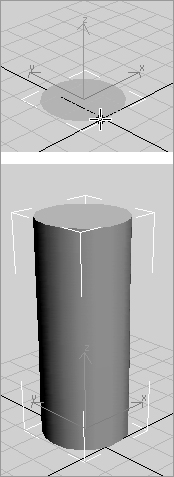
You’ll notice that as you move the mouse up or down, 3ds Max will pull the circle into a cylinder. Settle on a height for the cylinder and click to create the cylinder (Figure 2-15). Don’t worry about the size of the tube; we will modify it in the following steps to turn this cylinder into the top hanging bar for the mobile. Any size cylinder is fine for right now.
4. With the cylinder still selected, go in the Perspective viewport and click the Modify tab (![]() ) in the Command panel to bring up all the nifty tools you can use to modify objects in 3ds Max.
) in the Command panel to bring up all the nifty tools you can use to modify objects in 3ds Max.
You will rename the cylinder and size it to be a bar for the mobile. At the top of the panel, you’ll notice a text box with Cylinder001 and a colored square next to it, as shown in Figure 2-16. The color swatch is the object color, and it helps you organize your elements in a scene. The color is easily changed by clicking on the swatch and simply choosing another color from the window that pops up (as shown in Figure 2-17). This color is not necessarily the color your object will render in the final output of your animation (for more on rendering in 3ds Max, see Chapter 11, “3ds Max Rendering”). However, we are not too interested in the color of the bar right now, so you can leave the cylinder the way it is, or you can change it if you desire.
Figure 2-16: The Modify panel allows you to change the name of the selected object and its color in the scene.

Figure 2-17: The Object Color dialog box helps you organize the scene by letting you assign colors to your objects.
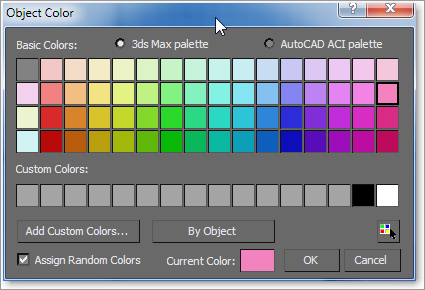
Figure 2-18: The parameters of a selected object (in this case the Main Parent cylinder) can be changed to suit your needs.
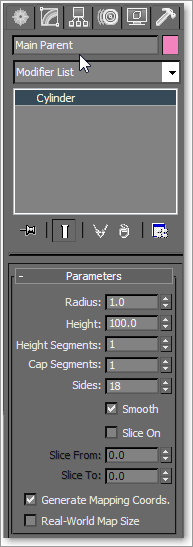
5. You do need to change the name of the cylinder, however. Click in the text box and change it from Cylinder001 to Main Parent. This name signifies that the cylinder will be the top bar of the mobile, and the top parent to the rest of the objects in the scene. For more on hierarchies, see the “Hierarchies” section earlier in this chapter.
6. You need to size the cylinder (Main Parent) to make it a bar. Under the Parameters heading in the Modify panel, you’ll notice a handful of parameters for Main Parent, as shown in Figure 2-18. If you don’t see anything there, make sure the cylinder is selected. The Modify panel will display the parameters for the selected object only. To adjust the parameters for the bar, you can type values directly into the appropriate boxes. You can also use the up and down spinners on the right either by clicking the arrows or by clicking and dragging up or down on the arrows. Change the Radius to 1, Height to 100, and Height Segments to 1 (as shown in Figure 2-18). Your cylinder should look like a bar, as shown in Figure 2-19, though you may need to zoom out your viewport to see it all.
Every object in 3ds Max will have parameters that define it geometrically in the scene. The exact parameters that are available for editing depend on the object that is being edited. For this cylinder, for example, you’ve already seen what the Radius and Height parameters do. The Height Segments, Cap Segments, and Sides parameters determine how many polygons you will use to define the shape, and hence how smooth it appears. Because the bar will not bend, you do not need extra polygons along the length. Therefore, the Height Segments parameter was changed from the default of 5 to 1.
Naming Objects and Keeping the Scene Organized
In 3ds Max, and in any CG package, it is incredibly important to keep things organized and as clean as possible. It’s no fun to pick up a scene from a colleague and waste tons of time trying to figure out exactly what is in it. Many artists will touch the same digital files and assets during a production. This is why many professional studios have strict naming procedures and conventions to minimize the confusion their artists may have when working in a pipeline. Even if you are the only person who will ever see a scene in 3ds Max, it is still an incredibly good idea to name and organize your objects. Get into the habit of naming your objects and keeping a clean scene. You will waste a lot of time if you don’t—not to mention the dirty looks you’ll get from other artists handling your cluttered scenes.
Figure 2-19: Your cylinder should be a thin bar.
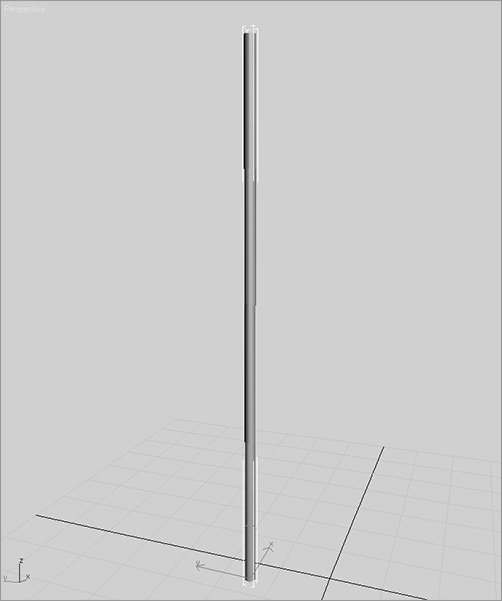
Positioning the Bar
Now you need to position the first bar, and then create copies for the other bars of the mobile, as shown in the following steps:
1. Click the Select and Rotate icon (![]() )—we’ll call it the Rotate tool from now on—in the Main toolbar just below the menu bar. (You can also use the hot key E to enable Select and Rotate.) Click on the Main Parent cylinder to select it, and enable the Rotate tool. Notice that the Rotate gizmo appears at the base of the cylinder.
)—we’ll call it the Rotate tool from now on—in the Main toolbar just below the menu bar. (You can also use the hot key E to enable Select and Rotate.) Click on the Main Parent cylinder to select it, and enable the Rotate tool. Notice that the Rotate gizmo appears at the base of the cylinder.
2. Clicking and dragging one of the axes will rotate the cylinder on that axis. For this step, click on the Y-axis rotate handle, which is the green circle, and drag the mouse to rotate the cylinder to the right of the screen, as shown in Figure 2-20. The green Y-axis handle will turn yellow when you move the cursor over it. (A gizmo’s active axis handle is yellow.)
Figure 2-20: The Rotate gizmo allows you to rotate the selected object.

Figure 2-21: Set the rotation to exactly 90 degrees in the Y-axis in the Transform Type-In box.

3. The bar needs to be rotated a perfect 90 degrees, and that is usually difficult to do by hand using the gizmo. Look at the bottom middle of the 3ds Max UI, and you will see the orientation of the bar in three text boxes called the Transform Type-In boxes. With the Rotate tool selected, you can enter a value of 90 in the Y-axis Transform Type-In box to set the bar to exactly 90 degrees, as shown in Figure 2-21.
Copying the Bar
In the next set of steps, you will copy the bar to make the other bars. Because the bar is already the size and orientation we need, it’ll be much faster to copy three more bars and place them. Copying objects in Max is quite easy if you follow these steps:
1. Click the Select and Move Tool icon (![]() )—we’ll call it the Move tool from now on—and select the bar. You can also invoke the Move tool with the hot key W.
)—we’ll call it the Move tool from now on—and select the bar. You can also invoke the Move tool with the hot key W.
You can also access the Move/Rotate/Scale and Select tools easily by right-clicking on the intended object to transform and picking the tool from the Quad menu that appears.
2. With the bar selected, hold down the Shift key and move the bar down in the Z-axis (by clicking on and dragging the Z-axis of the Move gizmo) by about five units, or grid squares. A second copy of the bar will form because you held down the Shift key as you moved. Move the copy down in the Z-axis with your cursor. As soon as you release the mouse button, the Clone Options window will ask you what kind of copy you want to make (Figure 2-22). We will cover the different types of copies and what they mean in Chapter 4, “Modeling in 3ds Max: Part I.”
Figure 2-22: The Clone Options window asks you the type and number of copies to make.
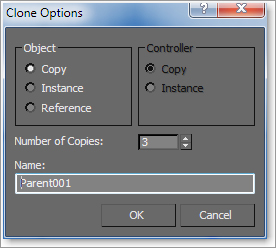
3. In the Clone Options window (Figure 2-22), keep the Copy button checked, enter 3 for the number of copies, and change the Name to Parent001. Click OK. 3ds Max will create three copies for you and position them as far down in the Z-axis as you moved the original clone while you had the Shift key pressed.
4. Use the Move tool to position the lower bars as shown in Figure 2-23; just don’t move the bars off the Z-axis; instead move them only in the X- and Y-axes by clicking on just those axes on the Move gizmo. (We will keep all the bars in the Z-axis plane for simplicity’s sake. After all, this is your first 3ds Max project; there will be plenty of time for confusion later.)
Try to position the bars so that the second bar’s center lines up with the left end of the top bar. The third bar’s center should be lined up with the top bar’s right end. The fourth bar can line up with the top bar. Each level of the bars should be about five units (or grid squares) down in the Z-axis from the last bar. Now you’re ready to make the simple hanging objects.
Figure 2-23: Position the bars for the mobile.

Creating the Mobile’s Objects
What kind of mobile has only four sticks hanging on a string? You’ll have to make some objects to hang from the ends of the bars. These objects will be simple shapes you can create with the following steps:
1. Activate the Front viewport by right-clicking inside it (by right-clicking, you will not affect any of your selections and you’ll still be able to activate the viewport). Maximize that viewport with the Maximize Viewport Toggle icon (![]() ) in the bottom-right corner of the 3ds Max UI.
) in the bottom-right corner of the 3ds Max UI.
2. In the Command panel, click the Create tab and then click the Shapes button (![]() ) to display the creation options for various shapes. The Splines option should appear in the Category drop-down list, as shown in Figure 2-24.
) to display the creation options for various shapes. The Splines option should appear in the Category drop-down list, as shown in Figure 2-24.
Figure 2-24: Creating spline-based shapes

3. Let’s start with a circle. Click the Circle button. Your cursor will turn to a cross as it did when you created the cylinder. This time, expand the Keyboard Entry rollout. Enter a value of 20 for the Radius under the Keyboard Entry rollout in the Create panel, as you can see in Figure 2-25. Click the Create button. A circle with radius 20 should appear at the origin. This is a way to make objects with precise dimensions, as opposed to clicking and dragging as you did to create the cylinder.
Figure 2-25: Under the Keyboard Entry rollout, you can enter the exact radius to use for the circle.

4. 3ds Max has given the circle you created the name Circle001, which is fine, so there is no need to change its name. Use the Move tool to position it under the second bar, lining up its center with the left end of the second bar, as shown in Figure 2-26. Splines, including the circle you just created, are not renderable
Figure 2-26: Position the circle under the second bar.
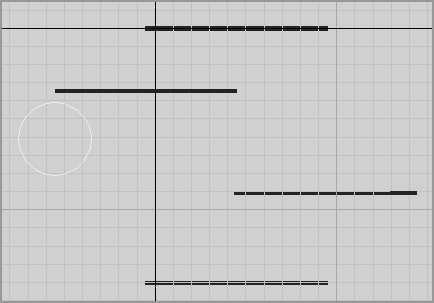
shapes by default. This means they will not render when you output your scene unless you specify otherwise. The circle will be displayed as a wireframe, even when the viewport is in Smooth + Highlights, mode (also called Shaded mode) when objects are shown as solid in the viewport. For more on display modes in viewports, see the “Viewport Modes” sidebar.
Spline shapes, such as our lovely circle, are curves that need to be given a surface to be able to render as solid objects. To make the circle solid, you will extrude it by following these steps:
1. Select the Circle001 object (the circle) and click the Modify tab (![]() ) in the Command panel.
) in the Command panel.
Under the Circle001 name text box, click the Modifier List pull-down menu to access the many modifiers you can add to the circle (Figure 2-27). Under the Object-Space Modifiers heading, select Extrude.
2. In the box below the Modifier List pull-down menu, a new entry called Extrude should appear above the existing Circle entry for the selected Circle001 object. This box, called the Modifier Stack, is shown in Figure 2-28. The Modifier Stack displays all the modifiers that are contributing to the selected object, in this case the circle. The Circle Modifier Stack entry holds the original parameters of Circle001, while the new Extrude modifier entry holds the parameters for the extrusion you just applied to the circle. The circle now has a surface and should display as solid in the Perspective viewport (Figure 2-29).
Viewport Modes
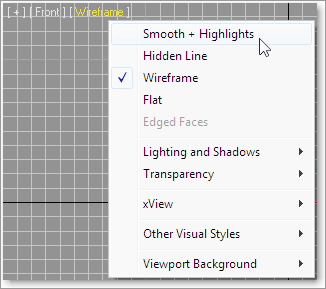
In Smooth + Highlights mode, you see the objects in your scene as solid objects. This is the default mode for all the 3ds Max Perspective viewports, but not for the Modeling viewports such as the Front viewport. To switch from one view mode to another, click on the display mode label in the upper-left corner of the viewport, next to the viewport’s name. A menu will appear, as shown here. You can also use keyboard shortcuts to change from one viewport to the next.
From the menu, you can select the view mode for that viewport. Additional display modes are listed under Other Visual Styles on the menu.
Figure 2-27: Modifier List pull-down menu

Figure 2-28: The Modifier Stack shows the Extrude modifier you just applied.

Figure 2-29: The circle is now a flat disc.

3. In the Modifier Stack, click the Extrude entry to bring up its parameters. Play with the Amount parameter to give the circle extrusion some depth and make a cylinder.
4. Let’s go off topic just for a second to cover something a bit more general about 3ds Max. Go into Wireframe view mode in your Perspective viewport by clicking the Smooth + Highlights mode name in the upper-left corner and selecting Wireframe from the menu (you may also press F3).
Now that you see the wireframe of the extruded circle, change the Segments of the Extrude modifier to see what happens. Figure 2-30 shows the extruded circle with Segments of 1 on the top, and Segments of 4 on the bottom. You’ll see that now there are more geometry divisions (called subdivisions), which make the object smoother lengthwise. Because you don’t need to bend this extruded cylinder, you do not need extra subdivisions along the length, so set the Segments back down to 1.
Figure 2-30: The extruded cylinder with a Segments value of 1 on the top and a Segments value of 4 on the bottom
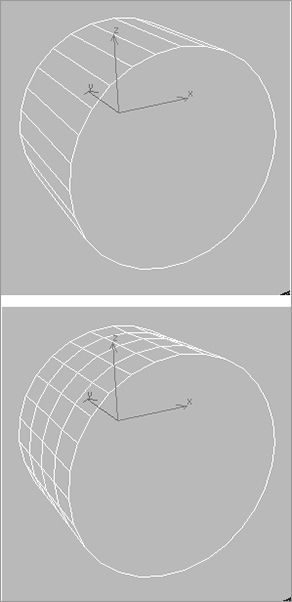
5. Back to the topic at hand, we need the circle to remain a flat disc, so set the Amount to 0.01 and keep the Segments at 1 as in the previous step.
6. Set the Perspective viewport back to Smooth + Highlights by clicking the Wireframe mode name, and selecting Smooth + Highlights from the menu. You may also press F3 to toggle between the two display modes. You should now see a flat solid disc, as shown in Figure 2-31.
Figure 2-31: The flat disc in Smooth + Highlights mode

7. Create a hexagon for the second shape. Go back to the Front viewport. In the Command panel, click the Create tab, then click the NGon button as shown in Figure 2-32. In the Parameters rollout, set the Sides to 6 for a hexagon. (An NGon is a polygon with N number of sides. In this case, N is 6 to make a hexagon.) In the Front viewport, click and drag to create the hexagon to a radius of about 20.
Figure 2-32: Setting parameters for the hexagon

8. In the same way you created the disc using an Extrude modifier on the circle, make a hexagon into a solid shape by adding an Extrude modifier to it. Select the hexagon (named NGon001). In the Modifier tab, click the Modifier List menu and select Extrude (as was shown in Figure 2-28). The NGon001 object will now have its own Extrude modifier in the Modifier Stack.
9. Use the Move tool (![]() ) to place the NGon001 hexagon below and lined up with the other end of the second bar. Figure 2-33 shows the solid NGon001 surface in position.
) to place the NGon001 hexagon below and lined up with the other end of the second bar. Figure 2-33 shows the solid NGon001 surface in position.
10. Create four more shapes and place them to line up under the ends of the remaining bars, as shown in Figure 2-34. You will need to create and extrude the remaining four shapes all at about the same size (radius of 20). The following table shows you the remaining shapes, what Object Type button to use to create them, and what their names will be in the scene. To avoid any confusion when we begin to set up the hierarchies for animation, keep the naming as shown here:
| Mobile Object | Creation Type | Object Name |
| Square | Use the Rectangle button. | Rectangle001 |
| Star | Use the Star button. | Star001 |
| Triangle | Use the NGon button, specifying three sides, and rotate to the orientation in Figure 2-34. | NGon002 |
| Donut | Use the Donut button. | Donut001 |
You should already have created these first two shapes:
| Mobile Object | Creation Type | Object Name |
| Circle | Use the Circle button. | Circle001 |
| Hexagon | Use the NGon button, specifying six sides. | NGon001 |
If you click and drag to create a shape in the Perspective viewport and nothing happens, you will need to switch to one of the orthographic views. In this Mobile example, make sure to create all the shapes in the Front viewport for simplicity’s sake.
Figure 2-33: The solid hexagon is in place.
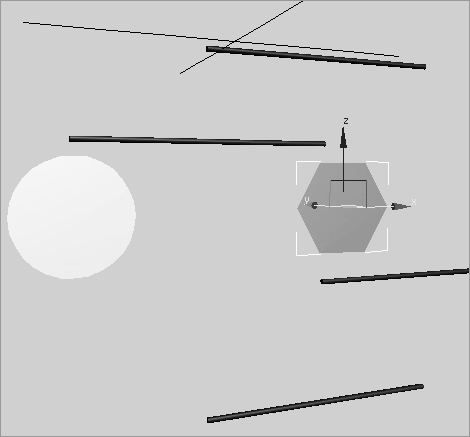
There you have it—a completed mobile model ready to set up and animate in Chapter 8. This exercise should have warmed you up to the 3ds Max UI as well as gotten you more familiar with the workflow. Go put your feet up and watch something dumb on TV for a little while; you’ve earned a break. It’s actually important to take a break at this point, and make sure what you’ve gone through makes some sense before moving on to Chapter 3 (about the UI) or Chapter 4 (where you start creating more complex objects). Feel free to go back and redo the exercise in part or in whole for a little more practice.
Save your progress, making sure to version up so that you don’t overwrite any previous scene files you might need later. You can check your work against the Mobile_v01.max scene file in the MobileScenes folder on www.sybex.com/go/intro3dsmax2011.
Figure 2-34: The shapes are now in position for the mobile.
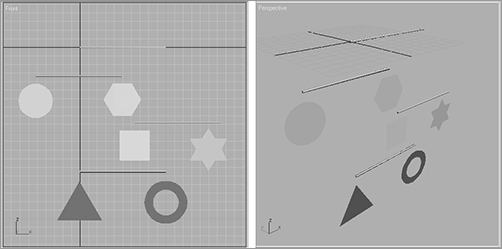
In this chapter, you learned how project management and file workflow help you keep things organized. You learned how to navigate the user interface to create and manipulate objects in the viewports, and you got a little hands-on experience to get to know 3ds Max better before plunging deeper into it in the following chapters.
